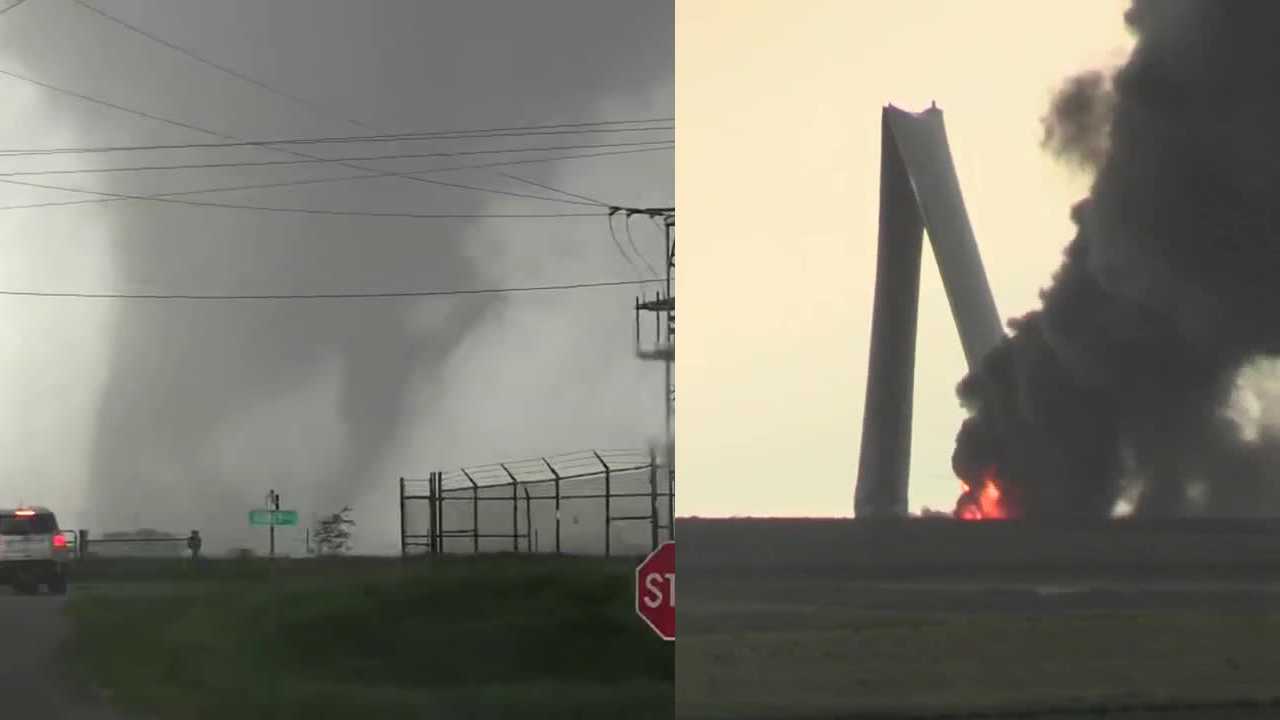Iowa Tornado History
Iowa tornado – Iowa, situated in the heart of Tornado Alley, has a long and well-documented history of tornadoes. The state’s unique geographical location, at the intersection of warm, moist air from the Gulf of Mexico and cold, dry air from the north, creates an ideal environment for the formation of severe thunderstorms and tornadoes.
Iowa has had its fair share of tornadoes, with one of the most notable being the tornado in Greenfield, Iowa in 2004. This tornado was an F5 on the Fujita scale, and it caused widespread damage to the town. However, the people of Greenfield came together to rebuild their community, and the town is now thriving once again.
Iowa tornadoes are a reminder of the power of nature, but they also show the resilience of the people who live here.
Iowa’s tornado history dates back to the 19th century. The earliest recorded tornado in the state occurred in 1844, near the town of Dubuque. Since then, Iowa has experienced numerous tornadoes of varying intensities, including several major outbreaks that have caused widespread damage and loss of life.
Iowa is no stranger to tornadoes, with its vast flatlands and frequent thunderstorms. For the latest information on any tornadoes that may be touching down in Iowa today, check out this up-to-date report on tornado in iowa today . Stay informed and stay safe during this severe weather season.
Notable Iowa Tornadoes
- 1878 Grinnell Tornado: This F4 tornado struck the town of Grinnell on June 17, 1878, killing 11 people and injuring dozens more. The tornado destroyed over 100 buildings and caused widespread damage to the town’s infrastructure.
- 1913 Parkersburg Tornado: This F5 tornado struck the town of Parkersburg on June 10, 1913, killing 75 people and injuring over 300. The tornado completely destroyed the town, leaving only a few buildings standing.
- 1973 Sioux City Tornado: This F4 tornado struck the city of Sioux City on June 3, 1973, killing six people and injuring over 100. The tornado caused extensive damage to the city, destroying over 500 homes and businesses.
- 2008 Parkersburg Tornado: This F5 tornado struck the town of Parkersburg on May 25, 2008, killing nine people and injuring over 100. The tornado completely destroyed the town, leaving only a few buildings standing.
Tornado Frequency and Statistics
Iowa is one of the most tornado-prone states in the United States. On average, the state experiences over 50 tornadoes per year. The majority of tornadoes occur during the spring and summer months, with May and June being the peak months for tornado activity.
The average path length of a tornado in Iowa is about 5 miles, and the average width is about 1/4 mile. However, some tornadoes can be much larger and more destructive. The largest tornado ever recorded in Iowa was the Parkersburg Tornado of 1913, which had a path length of over 100 miles and a width of over a mile.
Tornado Climatology: Iowa Tornado

Iowa’s tornado climatology is characterized by a high frequency of tornadoes, particularly during the spring and summer months. The state’s geographic location and meteorological conditions contribute to this tornado activity.
Meteorological Conditions
The formation of tornadoes in Iowa is influenced by several key meteorological factors:
- Atmospheric instability: Warm, moist air from the Gulf of Mexico meets cold, dry air from the north, creating an unstable atmosphere that is favorable for thunderstorm development.
- Wind shear: Changes in wind speed and direction with height create vertical wind shear, which can organize thunderstorms into rotating updrafts.
- Upper-level jet stream: A strong jet stream flowing over Iowa can provide the necessary energy for thunderstorm development and tornado formation.
Geographic Factors
Iowa’s geography also plays a role in its tornado activity:
- Flat terrain: The lack of significant topographic features allows for uninterrupted airflow, which can enhance tornado development.
- Central location: Iowa’s location in the central United States places it in a region where warm, moist air from the Gulf of Mexico and cold, dry air from the north frequently collide.
Peak Season, Iowa tornado
The peak season for tornadoes in Iowa typically occurs from April to June, with May being the most active month. However, tornadoes can occur at any time of the year.
Tornado Safety
The most important thing you can do to stay safe during a tornado is to be prepared. Have a plan in place for where you will go and what you will do if a tornado warning is issued. It is also important to know the signs of a tornado and to take shelter immediately if you see one.
The Iowa tornado season is upon us, and it’s important to be prepared. If you live in Iowa, you know that tornadoes can strike anywhere, anytime. That’s why it’s important to have a plan in place in case of a tornado warning.
One of the safest places to be during a tornado is in a basement or underground shelter. If you don’t have access to a basement, you can go to a designated storm shelter or Greenville, Iowa , which is a small town located in the northwestern part of the state.
Greenville is known for its beautiful scenery and friendly people. It’s also a great place to raise a family. But no matter where you choose to go, the most important thing is to stay safe during a tornado.
There are a number of things you can do to create a tornado safety plan. First, identify a sturdy building where you can take shelter. This could be your home, a school, a church, or a community center. Make sure that the building has a basement or an interior room without windows. Once you have identified a safe place, practice your tornado drill with your family. This will help everyone know what to do in the event of a tornado warning.
The Iowa tornado was a devastating event that caused widespread damage and loss of life. The storm, which struck on April 10, 2023, was the strongest tornado to hit Iowa in decades. It tore through the state, leaving a trail of destruction in its wake.
The tornado in Iowa was a powerful reminder of the destructive force of nature and the importance of being prepared for severe weather events.
It is also important to have multiple safe places in case of a tornado. If your first choice is not available, you should have a backup plan. This could be a neighbor’s house, a nearby business, or even your car. Having multiple safe places will increase your chances of finding shelter quickly in the event of a tornado.
Tornadoes are a destructive force of nature, and Iowa is no stranger to these storms. In recent years, the state has been hit by several tornadoes, including the devastating EF-5 tornado that tore through Parkersburg in 2018. For more information on the history of tornadoes in Iowa, please visit iowa tornado .
Community warning systems are an important part of tornado preparedness. These systems can provide early warning of a tornado, giving you time to take shelter. There are a number of different types of community warning systems, including sirens, weather radios, and cell phone alerts. Make sure you are familiar with the warning system in your community and know how to receive alerts.
Tornado Safety Tips
- Stay indoors and away from windows.
- Go to the basement or an interior room without windows.
- Lie down flat on the floor and cover your head with a blanket or pillow.
- Do not go outside during a tornado.
- If you are in a car, pull over to the side of the road and stay inside.
- If you are caught outside, lie down in a ditch or other low-lying area and cover your head with your hands.
Tornado Damage

Tornadoes are capable of causing severe damage to structures, infrastructure, and the environment. The extent of the damage depends on the intensity of the tornado, as well as the type of structures and terrain in its path.
Types of Tornado Damage
Tornadoes can cause a wide range of damage, including:
– Structural damage: This can include damage to buildings, homes, businesses, and other structures. Tornadoes can cause roofs to be torn off, walls to collapse, and windows to be shattered.
– Infrastructure damage: Tornadoes can damage roads, bridges, power lines, and other infrastructure. This can disrupt transportation, communication, and power supplies.
– Environmental damage: Tornadoes can damage trees, crops, and other vegetation. They can also cause erosion and flooding.
Factors Influencing Severity of Damage
The severity of tornado damage is influenced by a number of factors, including:
– Tornado intensity: The intensity of a tornado is measured on the Enhanced Fujita Scale (EF Scale). The EF Scale ranges from EF0 to EF5, with EF5 being the most intense. The intensity of a tornado is determined by its wind speed.
– Type of structure: The type of structure can also influence the severity of damage. Buildings that are well-constructed and anchored are more likely to withstand tornado damage than buildings that are poorly constructed or not properly anchored.
– Terrain: The terrain can also influence the severity of tornado damage. Tornadoes that travel over flat, open terrain are more likely to cause damage than tornadoes that travel over hilly or forested terrain.
Economic Impact of Tornadoes in Iowa
Tornadoes can have a significant economic impact on Iowa. In the past decade, tornadoes have caused billions of dollars in damage to the state. The economic impact of tornadoes includes:
– Property damage: Tornadoes can cause extensive property damage to homes, businesses, and other structures.
– Business disruption: Tornadoes can disrupt businesses by causing damage to buildings, equipment, and inventory.
– Job losses: Tornadoes can cause job losses by disrupting businesses and damaging infrastructure.
– Increased insurance costs: Tornadoes can lead to increased insurance costs for homeowners and businesses.
Tornado Recovery
Recovering from a tornado can be an overwhelming and challenging experience. The destruction and devastation left behind can be immense, and the path to recovery can be long and arduous. However, with the help of government agencies, non-profit organizations, and the community, it is possible to rebuild and recover from a tornado.
One of the most important steps in tornado recovery is to assess the damage and determine the needs of the community. This can be done by conducting damage surveys, which involve going door-to-door to assess the damage to homes and businesses. Once the damage has been assessed, government agencies and non-profit organizations can begin to provide assistance to those who have been affected.
Tornado Research

Understanding tornadoes is crucial for predicting their behavior and developing effective warning systems. Ongoing research focuses on improving detection methods, forecasting techniques, and developing early warning systems to minimize the impact of these destructive storms.
Latest Advancements
- Doppler Radar Technology: Advanced radar systems provide detailed information about tornado structure, wind speeds, and rotation, enhancing detection and warning capabilities.
- Numerical Weather Prediction Models: Computer models simulate atmospheric conditions to predict tornado formation and movement, enabling more accurate forecasts.
- Field Experiments: Researchers conduct field experiments to collect data on tornado dynamics, such as the VORTEX-SE project, which provided valuable insights into tornado formation and behavior.
Ongoing Research Projects in Iowa
Iowa State University and the National Severe Storms Laboratory conduct several research projects related to tornadoes in Iowa:
- Tornado Outbreak Forecasting: Developing statistical models to predict the likelihood and severity of tornado outbreaks.
- Tornado Warning Lead Time: Investigating methods to extend the lead time of tornado warnings by improving detection and forecasting techniques.
- Tornado Damage Assessment: Analyzing tornado damage patterns to understand the factors influencing building vulnerability and develop improved construction practices.